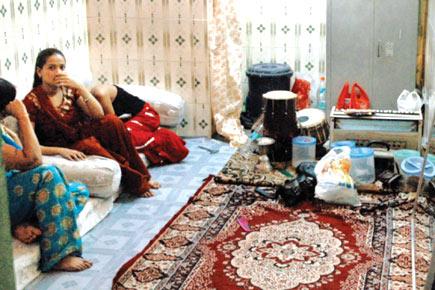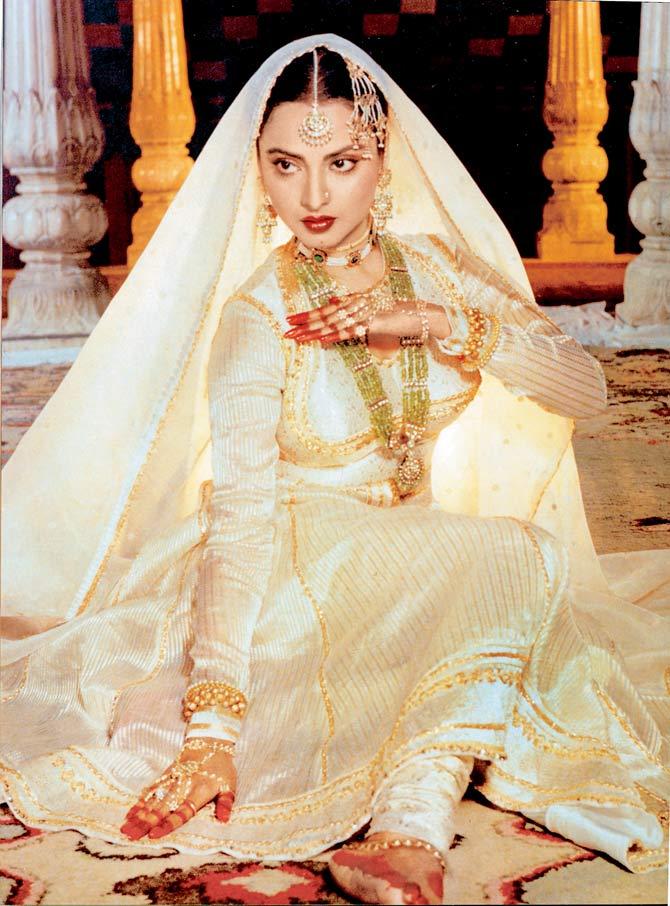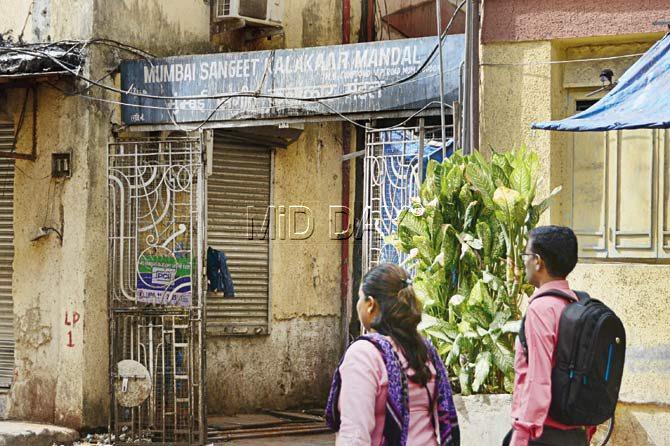In Mumbai Sangeet Kalakaar Mandal, often mistaken for Congress House, the traditional art form of the mujra is far from over. But, what you have now is a mish-mash, where Umrao Jaan's Rekha meets Ragini MMS' Sunny Leone

Mujra at the Bachubhai Wadi in Nagpada.
The long, winding road that comes to a halt below Grant Road's Kennedy Bridge, is a different picture after dusk. The daytime buzz of students from the nearby Queen Mary High School, and shopkeepers selling electronic wares, is sharply missing. So is the din of homemakers and vegetable vendors.
The street would have resembled any other residential pocket of Mumbai that lulls and slackens in the face of twilight, had it not been for the taxis that stop outside Beg Mohammed Compound. First, a girl appears in a shimmering lehenga; then, another over-decked damsel. They rush inside the rusty compound gate, without trying to draw attention. Slowly, a few cars endorsed only by the rich gather outside. The men, who step out, follow in the same direction as the girls.
ADVERTISEMENT
In the city's only surviving mujra den, Mumbai Sangeet Kalakaar Mandal, often mistaken for Congress House because of its proximity to the former headquarters (established 1925) of the Indian National Congress, this scene has been playing out on Vitthalbhai Patel Road for over half a century. Only now, it is a faint shadow of its former self, an old patron Deven Patel (name changed), tells us.
For many, the Mandal, like the mujra houses in the nearby Kamathipura area, has long been stripped off its iconic history and is witnessing a cultural decadence that would put its previous admirers to shame.
Suketu Mehta, in his book. Maximum City, had infamously described the place as "the biggest whorehouse in Bombay". The pimps, who throng outside the gate early evening, are a testimony of this deteriorating canvas. But, then there are a handful still holding onto the past, and a stroll inside the dingy alley is a reminder that there may be something missing, but it is yet to disappear completely.
A glorious past
Traditionally, mujras were performed by the tawaifs (courtesans), only for royalty. The art form traces its origins to the Mughal era and was commonplace in the erstwhile princely states when nobility was entertained with classical song and dance sessions in special houses called kothas or mehfils (gatherings). In return, the women would be rewarded generously, in cash or kind.

Rekha in 'Umrao Jaan'
The tradition was passed down from mothers to daughters, and became the source of income for the courtesans' families over centuries. "But, post-independence, when the women lost many of their rich patrons across the princely states of Uttar Pradesh, they migrated; some came to Mumbai," says history enthusiast Deepak Rao.
Their shift to the city was accelerated in the late 1960s. "In 1971, after Privy Purse (a payment made by the Centre to the royal families of princely states as compensation to integrate with India) was abolished, the nobility no longer had the money to spend on lavish gatherings," added Rao. And hence, the women had to look out for alternative places to pursue their art.
Farah (name changed) who runs a mujrakhana inside the mandal, belongs to one such family. "My mother who was struggling to make ends meet in Agra after Partition, came to the city in the late 1950s and started her work here," she recalls. "I took over from her, because this is our khandani pesha (family business)."
Patel, a cloth merchant from Kalbadevi, who was a regular client at the mandal between 1961 and 2000, remembers the place during its heydays. "Only the rich could afford it," he says. "The show of money was essential to the entire affair."

The gate of the Sangeet Kalakaar Mandal. Pic/Bipin Kokate
The "programme" as he calls it, would begin at around 8 pm, where two or three girls would greet you inside the kotha and get the customers to sit on the divan. Special paan (betel leaf) would be offered to the guests, before the performer would sit down on the rug and wear her ghungroo. "The wearing of the ghungroo was a beautiful affair. It was a kala (talent) in itself," says Patel, now in his late 70s. An orchestra, which included harmonium, bansuri and tabla players among others, would perform live along with the dancers. Songs from Pakeezah, Mughal-e-Azam and Umrao Jaan were most popular and remained in demand for years together.
Patel used to spend around Rs 10 to watch a mujra session during the 1960s. By 2000, the going price for a show could run into lakhs. The one protocol that, however, had to be maintained between the guest and the mujra performer was no touching the latter. "But, with the coming in of dance bars, discotheques and pubs, the mujra culture took a beating," says Rao, adding that a lot of women from mujra homes at the mandal moved to performing at the dance bars, some even to prostitution, because of a drastic drop in their clientele. The reputation they earned didn't help the art form, but only marred it further.
Nothing like the old
"Mujra is dead at Congress House," another old customer Ravi (name changed) says confidently. There is reason to believe him (and not), because the real story is locked inside. After a few days of struggle, we manage to get access to the fortress, which is otherwise guarded by pimps who gate-keep from dawn to dusk. The alley opens to two rickety buildings, with a small store and dargah within the compound. On the first floor of one of these houses, mujra performances still continue.
A row of mujra halls sits next to each other on the floor, with mirrored walls and chandeliers, embellishing its spacious interiors. The women, who are all dolled up in traditional lehenga-cholis and caked in make-up for their performance, walk past us indifferently.
"We have business for a change," says Farah, who has been running the show at the mandal for more than 35 years. "It's not like before, when you had a mujra performance every day. Now, we just dance, when we find takers for it. Our business has dropped by 75 per cent because people don't understand what a privilege it is to enjoy a mujra show anymore." The girls, however, are still in demand at weddings and special gatherings, where mujra is still duly recognised as a respectable art, Farah claims.
Before 2000, there used to be over 50 rooms where performances took place. Now, there are barely five halls within the entire complex; the rest have been converted into spaces for "other" activities.
Farah's cross-dressing Man Friday Rakesh (name changed), who hails from Gwalior and came to Mumbai in 2002, whines about how they don't have money to feed the many homes that survive on this art form. "But we will continue our work, because this is all we know," he insists, moving his hands agitatedly.
Even today, a guruji comes in each morning for a two-hour riyaaz with the girls. The duo claims that they play the traditional instruments only for customers, who want to enjoy traditional mujra.
"But, people like Bollywood hits these days. Who has the patience for 'Dil cheez kya hain?" says Farah, referring to the iconic Asha Bhonsale number from the 1981 film, Umrao Jaan. Straying from the original, there is also skin show, and if the dancer feels like it, she may tease her guests with a brush of the arm. Anything to flesh out that extra cash.
After a restless conversation, Farah asks us to leave. "We are going to begin any moment," she says, and leads us outside the hall. As we step out of the gate, a Sunny Leone number blares from the speakers upstairs. The party has just begun.
 Subscribe today by clicking the link and stay updated with the latest news!" Click here!
Subscribe today by clicking the link and stay updated with the latest news!" Click here!







